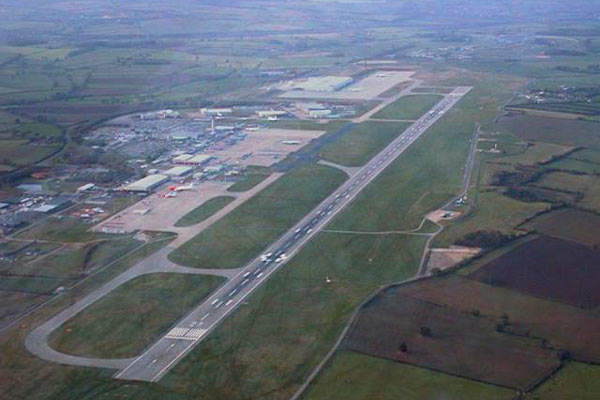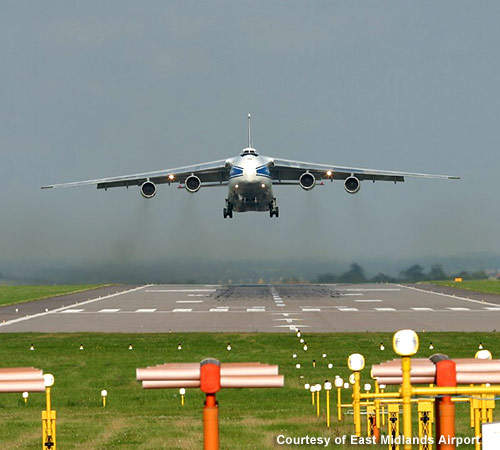Located in the town of Castle Donington in north-west Leicestershire, East Midlands Airport is about eight miles from the city of Derby and within 20 miles of Nottingham and Leicester. It is owned by Manchester Airports Group, which is itself owned by the ten metropolitan boroughs of Greater Manchester.
The airport was built in 1965 with a single 2,893m x 60m runway. It handled more than 5.6 million passengers in 2008, an increase of 3.8% over 2007, becoming the tenth-busiest airport in the UK in terms of passenger traffic and the second-largest cargo airport in the UK.
It is estimated that the airport will handle 9.2 million passengers a year by 2016 and between 12 million and 14 million a year by 2030.
The airport was a public enterprise before being bought by National Express Group for £24.3m in 1993. The group operated the airport for eight years after which, in 2001, Manchester Airports Group bought the airport for £241m.
The airport was renamed Nottingham East Midlands Airport in 2004 and East Midlands Airport in 2006. A £4m expansion of the existing runway was approved in November 2009. Permission was obtained to extend the runway by 190m.
Master plan
A master plan for the airport has been prepared for 2006 to 2030. It was first published in December 2006. Key developments include improving and expanding terminal facilities and increasing car parking space. Rapid access and exit points from the runway will be constructed in four to six years’ time.
Expansion
East Midlands Airport was changed from an air force station into an airport with a 1,780m runway, 18m taxiway, hangar floor, apron and parking for 800 cars. Since then it has undergone several developments.
The first expansion, at end of the 1970s, involved extending the runway to 2,283m and upgrading the terminal. In 1973 a second terminal meant for cargo opened and in 1986 the original terminal underwent a £3m extension.
National Express Group invested £77m in the airport during its ownership. Developments during that time included a 610m runway extension and a new £3.5m ATC tower.
In 2000 a new cargo facility was built for £35m. A business park was also constructed next to the airport.
Terminal features
The airport has one terminal. It features an information desk, an international currency exchange counter, car hire counters and a variety of shops. Other facilities include restaurants, video game counters, first aid stations, business class executive lounges and conference halls.
Self-service check-in desks and baggage reclaim are located on the ground floor, while the departures area is on the first floor. A dedicated bus service connects the airport to the rail network. The total area of the aprons is 350,000m².
Of the total cargo handled in the UK in 2008, East Midlands Airport handled 34.4%. A 140,000ft² cargo village is located at the airport, along with four other cargo terminals that occupy an area of more than 225,000ft². The east cargo apron occupies 60,000m² and the west cargo apron occupies 160,000m².
Air traffic control
The ATC tower at the airport opened in 1999 and stands 51m high. It has a visual control room, an approach radar room and a self briefing room. It also features an aerodrome traffic monitor, surface movement radar, a laser cloud base recorder, a VHF direction finder and its own radar simulator.
The radar controllers consist of a Marconi S511 primary radar scanner. A secondary radar backs up the primary radar. The tower uses a London Volmet North ATIS 128.225 weather information device.
Parking
The airport can accommodate 4,000 cars. It offers express parking, executive parking and economy parking. The express parking area is a short-stay facility located beside the terminal.
The executive or medium-stay car parking area, meant for a maximum of four days, is near the terminal and connected by a bus that travels to the main terminal building. The long-stay car parking area, for five or more days, is also situated near the terminal. The airport also has an off-site parking area that can accommodate 1,400 cars.
Environmental impact
East Midlands Airport gained the internationally accepted environmental management ISO 14001 accreditation in 2002. In 2003 the airport also won a national business award for environmental awareness. As part of the master plan, all aircraft running at night must be chapter four compliant by 2012.
The airport uses the latest technology to monitor air quality. The airport plans to use biomass fuels and set up windmills to utilise wind energy.













